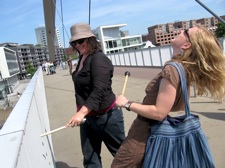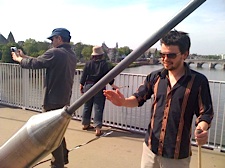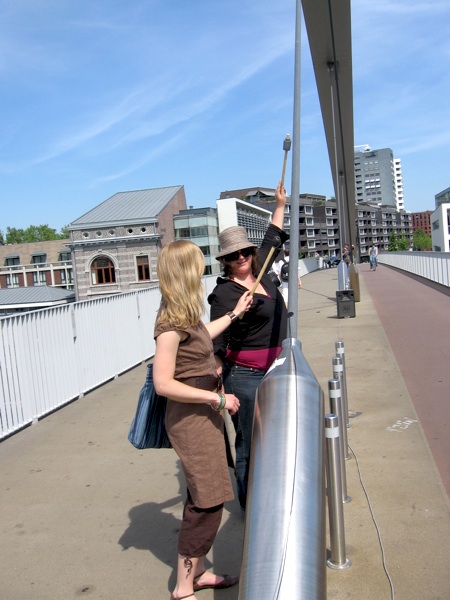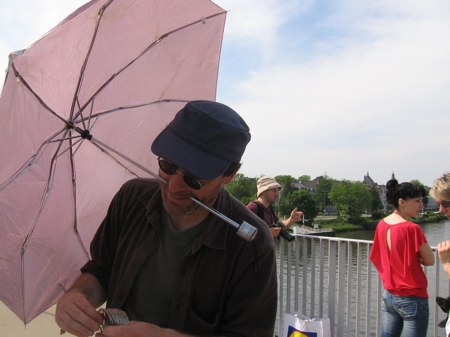"Also high bridges over the river" [KT2009, iii]
may 30, 2009.
"Auch hohe Brücken über die Flüsse [...]
Und die ganze Winterzeit dazu, das ist gefährlich."
( * )
We had a second jubilee last week in Maastricht. Not only did we celebrate
the 10th
edition of the Kunsttour, but as part of this Euregio
Kunstfest, visiting artist Jodi
Rose recorded and played her 50th bridge.
"There’s something about the scale of my obsession that sets it apart,"
Jodi was cited saying last year, in an article
in Alarm Magazine (#27, winter 2008). Indeed there is ... Just try to imagine as I just did, a chain of fifty bridges, one
laid out after the other ...
 |
 |
Jodi's of course far from the worst obsession one can imagine. Whatever way you look at them, from a purely technical/engineering point of view to a purely symbolic one, bridges are utterly fascinating artifacts, and an ongoing inspiration for painters, sculptors, filmmakers, writers and also singers. From Paul Simon's wishing to be like a bridge over troubled water for his silvergirl, to Jay-Z's rapping he's "got 99 bridges, but the britch ain't won". Or maybe that was 'problems'? Nevermind ...
I don't know whether anyone attempted yet to write a "History of the World in 99 Bridges". I can't remember ever having seen one, but maybe someday Jodi will. She did come to a fine place to do her 50th bridge, as Maastricht is very much a bridge town. Apart from the paleolithic remains just a little to the west of the modern town, dating back to tens of thousands of years BC, Maastricht earliest's traces are that of a Celtic settlement at a spot where most of the time it was easy to cross the river, de Maas (the Meuse). That was some 500 years before the Romans came and built a bridge there, sometime in the 1st century, and made crossing of the river possible at all times. That Roman bridge actually continued to serve for an incredible 1200 years. Due to lack of maintenance following severe battle-damage, several times in the 13th century, it collapsed in 1275 during a religious procession, causing the death of some 400 people.

The Roman bridge of course was a stone (and wood?) bridge, so it is pretty unlikely that its collapse was due to a phenomenon of resonance, caused by the coordinated shuffling of all those worshippers crossing it. As many viewers probably know, avoiding the occurrence of such resonance phenomena is the reason that when crossing a bridge, marching soldiers (or political activists, or whatever) should march 'out of step'. This is not an urban legend, mind you. A well-known example of the phenomenon occurred on april 16th, 1850, when 478 French soldiers marching caused the Angers Bridge to collapse. It is therefore that detailed calculations with respect to the eigenfrequencies and related physical properties of a bridge's 'finite elements', to become aware of the possible occurrence of unwanted flutter and vibration, are a necessary part of the construction- and engineering process in modern bridge building. It still happens though that only after it has been laid down, a bridge appears to be far more 'flexible' than intended. A recent example is the London Millennium Bridge, which shortly after its official opening in 2000 had to be closed down again, and modified, as indeed (citing Wikipedia here) 'the natural sway motion of people walking caused small sideways oscillations in the bridge, which in turn caused people on the bridge to sway in step, increasing the amplitude of the bridge oscillations and continually reinforcing the effect'. Like the proverbial little girl on a swing, indeed.
For similar reasons just a couple of years ago the Zouthavenbrug in Amsterdam had to be modified, as explained in this report (in Dutch). After its construction engineers tested the bridge by hitting it with a special sledge hammer. They also found that coordinated groups of pedestrians crossing were able to 'excite' the bridge into a vertical 'swing' with an amplitude of about 20 centimeters. In order to eliminate these effects one installed 'tuned mass dampers' to damp vibrations corresponding to the bridge's lowest two eigenfrequencies. Sort of like the wolf tone eliminators that are sometimes used on bowed string instruments to damp the tone with a frequency that corresponds to the natural resonating frequency of the instrument's body..
The most dramatic and well known example of what a bridge is capable of doing - surely because of the fabulous film of its collapse, due to the owner of a local camera shop by the name Barney Elliott - is the hour-long swing and ultimate collapse of the Tacoma Narrows Bridge, on november 7th, 1940. (Note the incredible elegance and rhythmic sway with which the long narrow bridge performs its swan song ... be sure to watch the two Tacoma Bridge Collapse clips below, the first one for its clarity and matter-of-fact ness, the second (a newsreel clip) for its completely over-the-top soundtrack.)
In Maastricht, on saturday may 23rd, we gathered on the Hoge
Brug (the High Bridge in english, or Hoeg Brögk, in the local dialect), the newest of five
Maastricht bridges crossing the Meuse and accessible to pedestrians and cyclists only.
Playing the bridge in Maastricht was a main reason for Rébus to come over
to Maastricht for the Kunsttour weekend. Emmanuel has a deep interest
in, more general, the vibration (and thus musical) properties of
large metal structures (heavy metal, yeah!). The construction of metal-based dynamic feedback-systems
- playable or autonomous - is one of his specialties, and so it is no wonder
that he indeed has a longstanding contact with Jodi over the 'singing of
metal bridges'.

There's many ways to play a violin, and one may think of many ways to play
a bridge. Exciting as it might be to try and find something like a bridge's
wolf
tone, to make it *really* sing by producing overtones to the natural
resonating frequencies of its body-elements, this would ask for research,
measurements, lots of data, calculations and sophisticated equipment. Even
given the technical means, it would take a lot of preparation and of time,
if only to convince the owners/municipalities who would probably be little
amused having a sound-artist and a crew of tech-whiz-kids descending on
their expensive bridges, wiring them up and then hitting them with mechanical
sledge hammers, to make them sway and whooshh in a veritable Bridges
Symphony... Or installing mechanical devices custom-made and strong enough to ever
so slightly pull and bend the cables that make so many bridges look like
gigantic harps with strings that are begging to be plucked by some
God or Overlord's
fingers...
Even, less ambitiously, to sonify and make hearable the multiple - very low -
vibrations that pervade a bridge and its divers elements in their day-to-day
use, one would need, for example, some type of accelerometer,
but certainly other than a set of simple contact
microphones.
But then no-one is more aware of this than Jodi herself. Lacking the means for costly tech material and support, she continues chasing her love with whatever there is at hand. And here and now these are the means not so much of a Bridge Virtuoso as those of a Bridge Punk: a handful of transducers, a couple of loudspeakers/amplifiers, a little mixing desk, some sticks and assorted pieces of metal. And a pink umbrella. ( ** )
All together it made for a hell of 50th bridge-day party out there on the Hoge Brug, with a blazing saturday afternoon sun shining down upon us. And it was not so much the Hoeg Brögk singing, as us hitting the poor thing hard, using it as a gigantic percussion set.
Rébus filmed it all, and cut his footage together into the following uTube.
No, the bridge itself refrained from singing. And no, it was not dangerous. But then this was parasol and suntan time,
with lots of mirth to chase our fears away. Far away seem'd wintertime and melancholy
evening. Neither was it the time between the night and morning that Shen
Te was warning us about ...
So here's to a Happy Bridge Day, Jodi! ...
Chances are that you will cross her on a bridge near to you, any day now.
[ Among those joining in on this first of two Kunsttour events on the Hoge Brug in Maastricht, you see, with the portable electro-touch drum-thing, Simon Berz, Seamus O'Donnell (both Simon and Seamus were also performing later that evening in the ArtSpace Rondeel, more about which in the next episode), and two Feedbacksociety-boys showing some muscle ... The second event, on sunday afternoon, must've been even better, but on sunday I was elsewhere. So let's ask Jodi! ]
next: Playing the Popular Classics [KT2009, iv]
[ previous KT2009-entry : A sound is a sound that sounds ]
SoundBlog entries about the yearly Kunsttour in Maastricht, the Netherlands:
(june 06, 2013) - A Carcassonne Yodel in Blue [Kunsttour 2013]
(july 03, 2011) - Life is a Color Wire 3 - table version [KT2011]
(june 17, 2010) - Sunny soundy days [KT2010, iii]
(june 10, 2010) - A kitchen table and a game of cards [KT2010, ii]
(may 30, 2010) - Auto*noom en un*titled [KT2010, i]
(june 13, 2009) - More Best Before [KT2009, v]
(june 01, 2009) - Playing The Popular Classics [KT2009, iv]
(may 30, 2009) - "Also high bridges over the river" [KT2009, iii]
(may 28, 2009) - A sound is a sound that sounds [KT2009, ii]
(may 23, 2009) - It feels like summer in the city [KT2009, i]
(june 06, 2008) - Raudio Graffiti: almost live ! [KT2008]
(september 04, 2007) - "leve ookoi!" - iii. ... under scare vogel crow vlucht score down ... [KT2007, iii]
(august 22, 2007) - "leve ookoi!" - ii. OK. Let's Dance... [KT2007, ii]
(august 12, 2007) - "leve ookoi!" - i. Certified Reconditioned [KT2007, i]
(june 04, 2006) - Sonofakunsttoer [KT2006]
notes __ ::
(*) Lines from a short text addressed to the public
by Shen Te, the protagonist in Bertolt
Brecht's play "Der
Gute Mensch von Sezuan". It was set to music by Hans
Eisler as part of his "Hollywooder
Liederbuch", and titled "Über den Selbstmord" (On Suicide).
[ ^ ]
(**) Which should suffice to reassure responsible authorities worldwide, and have them stand by with a
benevolent smile. Punks may brighten up your day, and bring about some fine and valuable local changes and actions,
but they
will not bring down your system. Similarly, a Bridge Punk will not collapse your bridge :-) ...
[ ^ ]
tags: Maastricht, Kunsttour, sound art, bridges
# .311.
smub.it | del.icio.us | Digg it! | reddit | StumbleUpon
comments for "Also high bridges over the river" [KT2009, iii] ::
|
Comments are disabled |